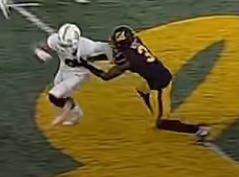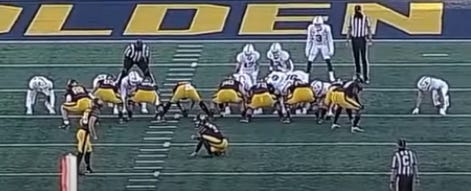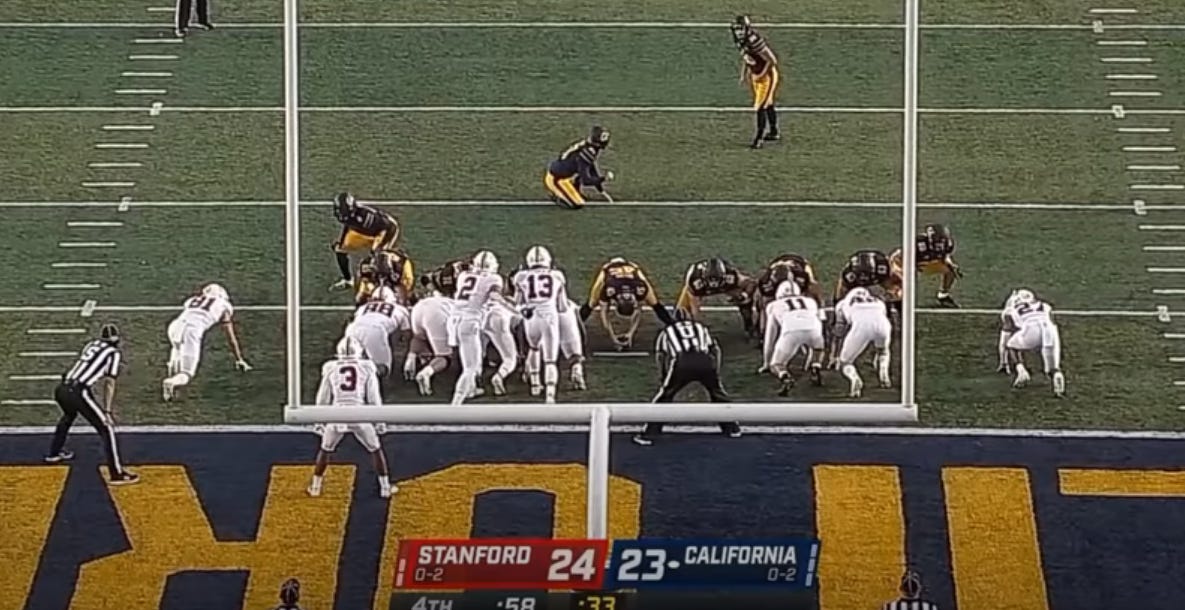Post Game Thoughts: 123rd Big Game
The Bears give away the Axe to a thoroughly undeserving Stanford in painful, mistake-prone performance
Way back in June, during the longest off-season ever, I wrote an article exploring the luckiest Cal wins and unluckiest Cal losses of the previous decade.
Lucky is of course a loaded word. Perhaps a better word for what I was going for would be unlikely. I was looking for games where Cal was the obviously superior team, but lost anyway through unlikely circumstances.
Well, great news everybody! We’ve got a new candidate for the list! Cal gained 6 yards per offensive snap to Stanford’s 4.5. 1.5 yards may not seem like much, but over the course of 132 snaps it adds up to a pretty significant advantage. Teams that display that level of per snap superiority typically win. To wit:
Bill derives post-game win expectancy by throwing all of the stat from the game into a blender and comparing them to how similar past games finished. Honestly, I’m surprised that Cal’s win expectancy wasn’t higher, but I suppose the Bears were dinged because they fumbled twice and Stanford didn’t fumble once. I’m also not precisely sure how kick blocks are factored into the equation.
Regardless, the general point still stands: this was a game the Bears should have won, and weird things had to happen to prevent that from happening. Sometimes weird things happen that are largely outside of your control. Sometimes it’s just you screwing up, and you have nobody to blame but yourself.
Offense
Efficiency Report
12 drives: 3 touchdowns, 2 FGA (1-2), 6 punts, 1 turnover (fumble), 1.9 points/drive
Note that I didn’t file Nikko Remigio’s fumbled punt as a drive. Also, if you want to credit the Cal offense for the scoring opportunities created, you could argue that they actually produced 2.25 points/drive. That’s not exactly amazing against Stanford’s below average defense, but it should’ve been enough to win the game.
The concerning absence of downfield passing
Chase Garbers averaged just 7.9 yards per completion, well below what Oregon’s Tyler Shough and Colorado’s Sam Noyer managed against the Cardinal secondary. Just last year, Cal’s comeback win was fueled by Chase Garbers throwing down the field, as the Bears averaged a robust 14 yards/pass completion. What gives?
The simplest, and thus most likely explanation, is that Garbers and/or Bill Musgrave generally don’t trust Cal’s inexperienced, make-shift offensive line to hold up in pass protection long enough for deeper routes to develop. Garbers took 4 sacks in (I think) 46 drop backs despite mostly getting throws out quickly, which is probably a fair representation of what the line is capable of handling right now.
Still, the inability to manufacture longer gains in the passing game and the particular inability to get Nikko Remigio involved as a pass catcher is concerning. It’s something that will have to get figured out if we’re going to entertain the possibility of upsetting the Ducks on Saturday.
To run or not to run?
Just last week I expressed my opinion that Cal needs to pass the ball more, because the run game was generally ineffective and reliant upon the aforementioned inexperienced, makeshift offensive line. The Bears proved me wrong by actually averaging more yards/run than yards/pass attempt. Cal running backs averaged nine yards/carry! Cal’s four longest plays of the game were all running plays/QB scrambles!
What do we make of this sudden reemergence of the running game? Is this a trend or a one-off performance?
Let’s start by highlighting the play of freshman Damien Moore, Cal’s offensive MVP. There’s no single aspect of his skillset that stands out as elite, but neither do I see a weakness in his game. He’s not blazingly fast but he hits holes decisively. He’s not absurdly strong but he’s one of those RBs with a knack for falling forward. More than anything else, he has uncommonly good vision, and I haven’t noticed him make a bad cut so far this year.
Still, a RB can’t do anything without blocking and the line was certainly better running the ball this week. We’ll find out soon if this was more a function of Stanford having a weak front 7. It is worth noting that Oregon had trouble stopping Stanford’s running game and was just gashed by Jemar Jefferson . . .
Defense
Efficiency Report
12 drives: 3 touchdowns, 1 FGA (1-1), 8 punts, 0 turnovers, 2 points/drive.
To be clear: This was Stanford’s weakest offensive performance of the season. Stanford produced their fewest yards/play, and if Jet Toner hadn’t ran out of ink against Oregon this game would also represent Stanford’s lowest points/drive of the season.
True, Stanford might easily have scored more points if David Shaw didn’t punt THREE times from within Cal territory. But let’s not pretend that Stanford spent the entire game racing down the field only to stall when they passed the 50 yard line. No, the Stanford offense inherited great field position, and mostly (sigh, mostly) wasted it. In 8 of their 12 drives Stanford failed to get more than one first down.
About as good as you can expect from a frighteningly thin Cal defense
Cal only played 14 different defensive players against Stanford - the starting 11, plus safety Trey Paster, safety Craig Woodson, and ILB Blake Antzoulatos. Eight players on defense played every single snap. And that’s despite playing two true freshmen (Paster and ILB Muelu Iosefa).
Cal’s secondary is in pretty good shape, as the Bears were able to cycle 7 players among the 5 secondary spots (Cal played nickel the majority of the game). But all three starting defensive linemen played every snap, as did Iosefu, Deng, and Goode at linebacker. Thanks to injuries, transfers, and attrition the Bears have almost zero depth at both defensive line and linebacker.
Nevertheless, it was the front 6 that held Stanford’s running backs to 4 yards/carry with a long of 11, and managed 4 sacks. To the extent that Stanford’s offense got anything, it was mostly Davis Mills and his receivers finding soft spaces in Cal’s zone coverages.
Two calls that swung the game
Immediately after the muffed punt, Stanford faces a 3rd and 5. They isolate Michael Wilson on Camryn Bynum, and throw an 11 yard fade for the touchdown. How did Wilson beat Bynum? He ran a pretty good route, Mills made a pretty good throw, and Wilson got away with a pretty nice push off:
I’m not shocked this wasn’t called. It was almost more of an arm bar to keep Bynum away than a standard push. But I would not have been shocked if this WAS called, which would have pushed Stanford into 3rd and 20 from the 26 yard line, with a likely non-gimme field goal to end the drive.
Midway through the 3rd quarter, with the game tied at 17, Daniel Scott intercepted a deep Stanford throw, but the interception was cancelled out by a hold from Elijah Hicks on Osiris St. Brown:
There’s not a ton to dispute about the call - Hicks grabs St. Brown as he moves down the field. But it’s also true that the hold doesn’t particularly impede St. Brown’s movement down the field, and Mills never even looks at Hicks. The hold was relatively minor and largely incidental to the play. It’s the kind of thing that wouldn’t be remotely surprising if it isn’t called. Stanford eventually scored a touchdown on the drive.
If either of these calls go Cal’s way, the Bears likely win. Turn a Stanford TD drive into a long field goal, and/or turn a Stanford TD drive into an interception, and that very easily swings a 1 point game. But these are the kind of 50/50 calls that can easily go against you in any given game, and football teams need to be good enough that these kinds of decisions aren’t the difference between winning and losing. If Cal executes the things that are in their control, they win in spite of both calls going Stanford’s way. Which brings us to . . .
Special Teams
Again, the difference between winning and losing
A muffed punt, a blocked field goal, and a blocked extra point. Swing any one of them and Cal at least takes Stanford to overtime.
Nikko Remigio’s muff was the most damaging of Cal’s special teams errors, and in my mind the most understandable. Remigio has returned 30 punts in his career, and that doesn’t count fair catches. I don’t remember him fumbling any of them. If you’re back there long enough, a fumble is more or less a matter of time, and it’s just unfortunate that it happened against Stanford.
The blocked kicks, however . . .
Notice anything similar about what Stanford did on both kicks? This is a fool me once, shame on you, fool me twice, shame on me situation if I’ve ever seen one.
Hey, at least Jamieson Sheahan had a bounce back performance
6 punts, for an average net of 40 yards/kick, is pretty solid. More of that and we can start to hope that last week’s debacle against Oregon State was a one-off event.
Big Picture
Justin Wilcox earned himself a ton of goodwill - more goodwill than Sonny Dykes EVER earned himself cumulatively as a Cal coach - just by beating Stanford last year. Such is the emotional significance of winning against the Cardinal.
I don’t know how much of his goodwill he gave back because of the fashion in which Cal lost to Stanford this time around, but it’s not an insignificant amount. Such is the emotional significance of losing against the Cardinal.
I’m not here to argue whether or not he should lose goodwill. While it’s true that a reasonable person might argue that this entire season is a pandemic-mulligan, I’m generally of the opinion that college head coaches get paid way too much money to not deserve significant scrutiny. When you’re paid 3 million dollars to coach amateur athletes, high standards are an expected part of the job description. I am here to argue that the very nature of fandom, and the specifics of Cal fandom, mean that there is suddenly increased skepticism and pessimism about the direction of the program.
I think the long term reality is that Cal fans will be willing to grant Wilcox something of a 2020 mulligan . . . contingent on an improved 2021 season. If the Bears beat Stanford and are strongly competitive in the Pac-12 North, much of this season’s absurdities will be brushed aside. If, instead, 2021 looks at all similar to what the Bears have shown on the field this year, the fan base will likely have a very short fuse.
My short term take? When you build your team to be a generally conservative, defense-first outfit that minimizes mistakes . . . well, you can’t make a bunch of mistakes. Negative two in the turnover category and two short blocked kicks, one week after a different flavor of special teams disaster turned a likely win into a loss, kinda cuts into belief in that team building philosophy.
This season is going to be (mercifully) over in a matter of weeks. At this point, I doubt anybody cares all that much whether or not we beat Oregon, Washington State, or (likely) Arizona in a series of mostly meaningless games to finish the ‘season.’ I mostly want to see one win, for the sake of the players who put in the risk and effort to play this year.
The focus will quickly turn to a very consequential off-season, one that Justin Wilcox will have to spend determining what went wrong this year, and how to fix it.







Like anyone who read one of christopher_h's LSJU offense previews from the last couple seasons, I was extra salty about that offensive PI. They're as bad about OPI as Oregon was with holding during the Kelly/Helfrich years.
Someone else commented (sorry, cant recall who) on a previous article.. If you are to be a defensive minded football team, you'd damn better also have good special teams. It's so true, and this needs to be a major focus going forward, and it seems it will be according to coach's post game presser. Also, great write-up as usual, Nick -- thank you, sir.